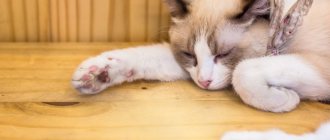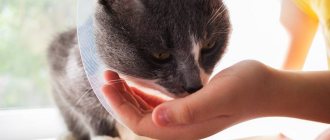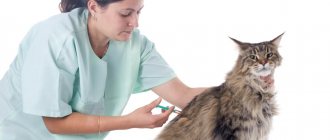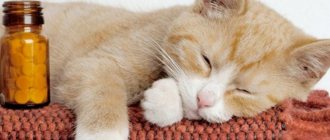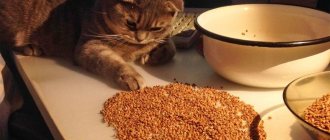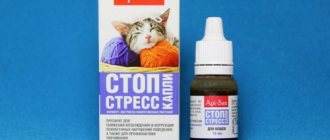7533Pavel
2
Owners of furry meowing pets may encounter any deviations or disturbances in the health of their pets. This deviation can be loose stools in cats, or, more simply, diarrhea. Can cats take Loperamide? – a question that arises among owners who urgently want to help their pet, but do not have suitable medications for animals in their veterinary medicine cabinet.
Diarrhea in cats can occur due to poisoning, poor diet, infection, parasites, allergies or gastrointestinal diseases. As a result of prolonged diarrhea, the cat becomes dehydrated, which threatens to impair blood circulation in the brain. For this reason, the alarming and dangerous symptom should be immediately eliminated, and Loperamide can help with this.
© shutterstock
What is Loperamide?
Loperamide is a drug for the symptomatic treatment of diarrhea. However, this is the abbreviated name for the substance loperamide hydrochloride, which is on the Model List of Essential Medicines compiled by the World Health Organization.
Did you know? « Loperamide
»
was developed in 1969 by employees of Janssen Pharmaceuticals.
This is an active substance that leads to the desired result in the treatment of diarrhea.
The element is found in various drugs that are considered analogues and have an antidiarrheal effect.
Phthalazole during pregnancy and lactation, breastfeeding
The use of phthalazole during pregnancy and lactation for the treatment of diarrhea and frequent loose stools is allowed only if absolutely necessary at the end of the first trimester and provided that the expected benefit for the woman is higher than the risk of harm to the child. Due to low absorption, the direct negative effect of the drug on the fetus and its development has not been established, however, there is a risk of negative manifestations on the part of the mother’s body.
We invite you to familiarize yourself with the Chihuahua dog: description and characteristics of the breed, features of maintenance and training
No deviations during pregnancy and labor as a result of taking phthalazole were identified. During lactation, taking Phthalazol to treat diarrhea is not recommended, since it penetrates into the milk through the bloodstream and, with prolonged use, can cause disruptions in the intestinal biocenosis of the baby.
The drug is prescribed to nursing mothers only in extreme cases. If a nursing mother is still undergoing treatment with Phthalazole, the tablet should be taken after feeding. To prevent bacterial imbalance, the child may be prescribed eubiotics at this time. In extreme cases, babies with glucose-6-FDG deficiency are diagnosed with kernicterus and a hemolytic reaction.
Chemical composition and characteristics of the drug
The composition of the drug "Loperamide":
- loperamide hydrochloride (2 mg based on 100% substance);
- lactose monohydrate;
- potato starch;
- calcium stearate.
The active substance, loperamide hydrochloride, impairs intestinal motility. At the same time, it increases the transit time of intestinal contents through the digestive tract and improves the ability of the intestinal walls to absorb moisture. The anal sphincter comes into a state of tone, delaying fecal incontinence. Thus, Loperamide provides symptomatic treatment and helps control the urge to defecate.
Contraindications and side effects
This drug is not advisable for the treatment of diarrhea in cats if the true cause of the diarrhea is unknown. Loperamide should be given to a cat for diarrhea only after making sure that the animal is not at risk of intoxication or there are no other contraindications. Loperamide should also not be given to kittens under 3 months of age.
Contraindications:
- Allergic reactions to the components of the drug;
- Poisoning with poisons of inorganic origin;
- Stomach ache;
- Intestinal ulcer;
- Intestinal obstruction;
- Pregnancy and lactation in cats;
- Acute poisoning and allergies;
- Dysentery;
- Glaucoma;
- Kidney failure;
- Intestinal flatulence;
- Constipation;
- Diverticulosis.
Loperamide should be given to a cat very carefully together with other medications, due to possible adverse reactions. Taking Loperamide can enhance and inhibit the effect of some other drugs, which will jeopardize the health of the animal. For this reason, it is recommended to refrain from combining this drug with monoamine oxidase inhibitors, antihistamines or tranquilizers to avoid problems.
Side effects after administration may occur if the dosage of Loperamide for a cat for diarrhea has been exceeded. Also often at risk are kittens up to one year old, for whom it is difficult to calculate the optimal dosage.
Is it possible to give a cat Loperamide for diarrhea?
Loperamide is intended primarily for people. However, in some cases the drug can be given to animals, including cats. It is important to remember that diarrhea is not a disease, but a symptom. Initially, you need to cure the cause of its appearance. Diarrhea is often caused by poor diet. To alleviate the cat's condition, the use of medication is allowed. However, this should not be the only treatment.
First of all, enterosorbent and temporary refusal of food will get rid of the disease. In cases where diarrhea does not stop for a long time and is combined with vomiting, the presence of an infectious pathogen in the microflora is possible. However, it is impossible to make a diagnosis on your own; the cat must be shown to a veterinarian.
Important! If there are black impurities and blood in the cat's feces, it is prohibited to give Loperamide. Such symptoms indicate internal bleeding, the animal should be immediately shown to a veterinarian.
In case of diarrhea, it is quite difficult to bring the animal to the clinic due to involuntary defecation. It is in this case that it is permissible to give the cat medication. Loperamide may be prescribed by a veterinarian during treatment. This is a symptomatic auxiliary therapy that can alleviate the animal’s condition.
What's wrong with my cat? help me please
When my cat got sick, I gave him Polysorb, it helped
Helps quickly stop diarrhea of any etiology. This reduces fluid loss and prevents the development of dehydration. 2.1 Method of using phthalazole for dysentery. 3 Indications for use in children.
We invite you to familiarize yourself with the Orpington breed of chickens - description, photos and videos
What does he feed? dry food?
Phthalazole helps cats with diarrhea. It is very cheap and almost tasteless (a cat will swallow it without any problems). Divide the tablet into 4 parts and give to the cat during the day - 1/4 tablet every 6 hours. The improvement is noticeable already on the first day, but it is better to give the medicine for 3-4 days.
In general, cat feces depend on their diet, and also on age, since any pets, like people, develop problems with age. Therefore, watch your pet’s diet.))) And phthalazole. WITH:
If you feed Kitiket (I read it in the comments), then you don’t need to go far to get a diagnosis. Economy food produced in Mars (kitiket, whiskey, etc.) are made from a variety of waste that was not used in the production of human food. Plus harmful special additives and dyes are prohibited. The consequences of “whiskey-whiskey” feedings in cats are varied.
Gastritis, enteritis, pancreatitis, kidney failure, liver problems. Even to the point of oncology. It’s strange that you keep an animal and have never heard about it. The food needs to be changed urgently. Most likely, medicinal feed will now be needed for recovery. Your veterinarian should recommend them to you after he has examined you.
I treated mine with furazolidone, sold in a human pharmacy
If DIARRHEA took you by surprise. Phthalazol. It really twisted me then! In addition to nausea, vomiting and abdominal pain, severe diarrhea also developed. That's when I became acquainted with this drug.
You need to feed your cat properly.
The benefits and harms of the drug
The benefit of the drug is manifested in the deterioration of intestinal motility. Fecal masses no longer come out spontaneously. Thus, the animal’s condition improves, which allows the basic treatment to be carried out effectively.
Harmful effects are possible in the following cases:
- overdose;
- self-prescription without consulting a veterinarian;
- lack of primary treatment.
If the cause (poisoning, bleeding or infection) is not treated, the animal’s condition will worsen.
In case of overdose, side effects may occur. You will be interested to know what diseases cats suffer from.
Contraindications to the use of phthalazole
Prohibiting factors for the prescription and use of Phthalazol are: acute hepatitis and renal failure, hypersensitivity to the components of the drug, or previously to sulfonamide drugs, colitis and enterocolitis of fungal origin, Graves' disease, blood diseases, impaired coagulation.
Side effects of the drug
It is very important to know when diarrhea cannot be treated with Phthalazole, when treatment of diarrhea with the drug may be contraindicated. The main reason for side effects when using Phthalazol is hypersensitivity. Based on the poor absorption and low penetration of the drug into the bloodstream, toxic consequences after its use are quite rare. They manifest themselves through skin rashes accompanied by itching, urticaria, fever, atypical dermatitis, hyperthermia, vesicular rashes.
Considering that phthalazole interacts with intestinal microflora, its long-term use is fraught with dysbacteriosis. If the suppression of the natural bacterial environment is strong enough, there is a possibility of hypovitaminosis B. Long-term use of phthalazole triggers processes that prevent the proliferation of blood cells, which can result in the development of aplastic anemia or agranulocytosis.
Features, what else you need to know
People suffering from renal failure, hemophilia, inflammatory disorders of the kidneys (urolithiasis, pyelonephritis, glomerulonephritis) and liver pathologies should refrain from using phthalazole. With such diagnoses, there is a high probability of cross-allergic reactions and the development of hypersensitivity to the elements of the drug.
Drug overdose
Exceeding the prescribed dose of Fthalazol causes a macrocytic reaction and pancytopenic phenomena. To correct the situation, the patient should take folic acid. Side effects affecting the ability to drive cars or complex machinery have not been identified. The drug is sold without a prescription.
Scheme and methods of application
Loperamide should not be administered to kittens until they are 3 months old. If necessary and prescribed by a veterinarian, the drug can be used in 6-month-old animals. After six months, cats in most cases accept the medication normally.
We recommend that you familiarize yourself with the drugs for the gastrointestinal tract: “Enterofuril”, “Furazolidone”, “Smecta”, “Fthalazol”.
Veterinarians recommend the following dosages:
- kittens up to 1 year old - 0.1 mg per 1 kg of weight.
- adult cats - 0.05 mg per 1 kg of weight;
The dose for young animals is higher due to their fast metabolism. The indicated doses are used 1 time per day. Loperamide should not be given to animals at home for more than 2 days due to the risk of overdose.
Dosage of the drug
The next, very important nuance is the exact dosage. Since the drug is intended for humans, you will not find anything in the instructions for treating cats. The average dose for an adult cat is no more than 1/2 tablet per day; a kitten should not be given more than 1/4, and preferably no more than 1/8 tablet.
Loperamide is not recommended for use in kittens, since after taking the drug the pet cannot be fed for 24 hours, and a safe fasting diet for a kitten lasts up to 12 hours.
To accurately divide the tablet into doses, it must be dissolved in water. Grind the tablet into powder and pour it into the syringe. Then insert the plunger and draw in water. It is more convenient to use a 1 or 10 ml syringe (multiples of 10 units). Shake well to dissolve the powder; it is better to use warm water.
Use the plunger to release any excess medication from the syringe so that the plunger does not accidentally break off. Next, you need to carefully pour the resulting suspension into the kitten’s mouth, naturally without a needle. For each dose of the drug, you need to dilute a new tablet, but keep in mind that even one dose of Loperamide can greatly harm the kitten if the cause of diarrhea is not accurately determined.
Loperamide is not recommended for long-haired cats if there is a possibility that the symptoms are caused by hair accumulated in the stomach.
What not to do
In order not to provoke complications and achieve results in treatment, it is important to follow the following rules:
- Do not give antibiotics without a doctor's prescription.
- get rid of the smells of household chemicals and other heavy odors in the apartment.
- do not increase the safe period of treatment.
- You cannot let the animal go outside.
- Do not give dry food if you have diarrhea.
For safe treatment, you should always contact a professional. This condition will allow you to avoid complications and cure your cat in the most painless way possible. The doctor will tell you exactly what you can give your cat for diarrhea and will draw up a treatment plan and identify the cause of the poor health. Your pet may need a special diet or nutrition plan.
Sources:
https://koshkamurka.ru/8394-ftalazol-dlya-koshek.html https://pets2.me/bok/2009-kak-davat-ftalazol-kotu.html https://gafki.ru/koshki/chto- dat-kotu-ot-ponosa.html
When do you need veterinary help?
Every owner should know: diarrhea in cats is a very dangerous symptom if it is not associated with errors in the pet’s diet. During diarrhea, water reserves are lost from the animal's body, which can lead to dehydration. If the owner encounters this symptom in a pet for the first time, then you should not delay providing help or self-medicate.
The health and even the life of the animal may be at stake, because loose stools can be caused by serious pathologies in the gastrointestinal tract, infection or severe poisoning. In any case, it would be wise to take your pet to the clinic and see a veterinarian. The doctor will conduct an examination, take the necessary tests, identify the cause of diarrhea and prescribe effective treatment. It is important to remember that giving Loperamide to a cat for more than two days is dangerous; it is also worth taking into account the animal’s age and individual characteristics.
When cats develop diarrhea, owners begin to panic and look for treatment methods. The first thing that comes to mind is to give the animal Loperamide, because it is an effective drug for diarrhea in humans. However, the use of the medication should be used with caution. Read about the characteristics of the drug, indications and harmful effects below.
Precautions for use
When using the drug, you must strictly observe precautions and adhere to the dosage prescribed by your doctor . The active substance of the drug has a negative effect not only on pathogenic microorganisms, but also on the natural intestinal microflora. That is why, if the drug is taken for too long, the body may develop a lack of active biological components of group B, in particular, thiamine, riboflavin and nicotinic acid.
Fthalazol should not be given to cats during pregnancy, as it can provoke serious allergies, vomiting, and fever, which, in turn, can lead to miscarriage or pathological disorders in the development of kittens.
Important! The described drug should not be taken together with drugs of the oxacillin group.
Basic characteristics
Have you seen the Imodium commercial on TV? If yes, then you already have an idea about the composition we are describing. In fact, this is a cheap analogue of the advertised brand. It is sold under the names Imodium/AD, Pepto Diarrhea Control, Kaopectate II Caplets. All this is the same thing. Differences in prices and manufacturer.
Available in the form of capsules, tablets and gel for oral use. Used to eliminate diarrhea and inflammatory diseases of the entire gastrointestinal tract. It has nothing in common with anti-inflammatory corticosteroids, although from a chemical point of view there are certain similarities.
Important! Not recommended for administration to cats! For dogs, by the way, there are no such restrictions. If there is any alternative, use it. In the case where a decision has been made to prescribe this particular remedy, this must be done under the strict supervision of a specialist.
The advantages include accessibility: you can buy it at any pharmacy. The action is based on the compound’s ability to inhibit intestinal motility, as a result of which the evacuation of feces is significantly slowed down. At the same time, the product simultaneously impedes the absorption of high-molecular substances of protein and inorganic nature. In Russian, water in the intestines will be absorbed, but toxins will not (but not everything is so good in practice).
Please note that this drug should be given to your pet for a maximum of two days. If no positive results are observed, we recommend that you contact the clinic immediately. Most likely, the diarrhea in this case is associated with something more serious than ordinary food intolerance or overeating. In addition, at the same time, we advise you to feed the cat exclusively with liquid broths, refusing more “serious” food.
Analogs and price
The price of Loperamide in tablets of 2 mg, 10 pieces, is 16 rubles. The product is in the form of capsules, 2 mg, 10 pcs. costs 11 rubles. Analogs of Loperamide are all medications that suppress peristalsis. The list of drugs and their prices are given in the table below:
| Medicine | Price |
| "Imodium" in lyophilized tablets, 2 mg, 10 pcs. | 228 rub. |
| "Lopedium" tablets 2 mg, 10 pcs. | 51 rub. |
| "Uzara" tablets 40 mg, 20 pcs. | 98 rub. |
| "Stopran" in capsules 2 mg, 8 pcs. | 130 rub. |
Loperamide can be used to treat diarrhea in cats, but with caution. If possible, do not self-medicate. It is better to take your pet to a veterinarian to avoid possible harmful consequences.
No cat owner is immune from the fact that their pet may get sick; most often cats suffer from digestive tract disorders. When an animal has loose stools, the owner wants to help with some medicine from his own first aid kit. A common question that the veterinarian is asked is whether Loperamide can be given to a cat for diarrhea.
How to give
In order for the treatment of diarrhea in cats to be effective and not cause harm, a clear dose must be established. Loperamide should be given to a cat at the rate of 0.05 - 1 mg per kilogram of animal weight. It is worth considering that 0.1 mg per kilogram of weight is recommended for one-year-old kittens due to accelerated metabolism, and 0.05 mg per kilogram of weight for adult pets. Loperamide comes in the form of tablets, capsules and pastes, and regardless of the form of release, it is given orally. This drug should be given to your pet only as prescribed by a doctor, carefully calculating the required dosage. Treatment should not exceed two days unless the animal is under the supervision of a veterinarian.
Examination of the cat and diagnosis
The veterinarian will first conduct a full examination of the animal, ask the owners about the dietary habits that preceded diarrhea, the circumstances and the possible stress of the cat.
Laboratory tests will help clarify the cause of the disease, the degree of dehydration and the stage of inflammation. In order to verify the integrity of the walls of the digestive tract or, conversely, to prove the presence of damage, tumors or foreign bodies in it, contrast radiography is performed. The method is relatively safe and highly informative.
If helminth infection is suspected, a stool test is performed. The research method is microscopic. The smear reveals worms and parasite eggs.
If kittens are bothered by diarrhea, accompanied by weight loss and dehydration, they should have their stool tested at the age of one and a half months. This should be done in the absence of a specific pathology. If the test result is negative, it must be repeated at 6 and 9 months to be completely sure of the kitten’s health.
For kittens, diarrhea can cause rectal prolapse. Most often, with timely treatment, the process is reversible. If the prolapse is not eliminated after the pet’s recovery, surgical intervention is necessary.
